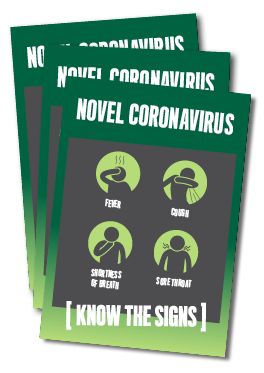Coronavirus (COVID-19) health alert
We are monitoring a respiratory illness outbreak caused by a novel (new) coronavirus (COVID-19). We update this alert every day with the latest medical advice and official reports.
Current status
In Australia
As at 06:30 hrs on 25 February 2020, we have 22 confirmed cases of coronavirus (COVID-19) in Australia:
- 8 in Queensland
- 4 in New South Wales
- 6 in Victoria
- 3 in South Australia
- 1 in Western Australia
15 of these cases are reported to have recovered. The remaining cases are in a stable condition.
7 cases are passengers who were on the Diamond Princess repatriation flight from Japan. They were in quarantine at the Manigurr-ma Village Howard Springs facility in Darwin when they tested positive to coronavirus (COVID-19).
All of these people have returned to their home states for medical treatment.
For questions about testing or the welfare of people with the virus, contact your state or territory health authority.
For more information, read the latest transcripts and media releases about coronavirus (COVID-19) in our news section.
Across the world
Across the world, there have been about 79,573 confirmed cases of coronavirus (COVID-19) and 2,626 reported deaths. Of confirmed cases reported globally, the case fatality rate is approximately 3.4%. The case fatality rate in countries and regions outside mainland China is 1.4%
The majority of cases of COVID-19 have been reported from mainland China. 2,423 cases have been reported from 37 countries and regions outside mainland China.
Since 24 February there have been 225 new cases reported outside of mainland China. The majority of these cases are from Italy, South Korea and Iran.
Why is there an alert
On 30 January 2020, the World Health Organization declared the coronavirus outbreak a Public Health Emergency of International Concern.
The Australian Government has issued this health alert as a precaution, based on the latest and best medical advice.
Learn more about coronavirus (COVID-19)
Find out more about coronavirus (COVID-19) and how to protect yourself.
Separate fact from fiction by reading coronavirus myth busters on the World Health Organization website. This includes information about when and how to wear a surgical mask.
We also have a series of information sheets to help you, your family, health professionals, aged care workers, educational facilities, and the travel industry.
Coronavirus (COVID-19) resources
A collection of resources for the general public, health professionals and industry about coronavirus (COVID-19).
Coronavirus (COVID-19) resources in Simplified or Traditional Chinese
A collection of resources about coronavirus (COVID-19) in Simplified or Traditional Chinese.
Information for the health sector
View our resources for health professionals, including pathology providers and healthcare managers.
Also read the 2019-nCoV National Guidelines for Public Health Units that were updated by the Communicable Diseases Network Australia on 19 February 2020.
For information about the epidemiology of cases in Australia and overseas, read the weekly epidemiological reports.
Australian Health Sector Emergency Response Plan for Novel Coronavirus (COVID-19)
The Australian Health Sector Emergency Response Plan for Novel Coronavirus (the COVID-19 Plan) was endorsed by the Australian Health Protection Principal Committee on 17 February 2020.
The Australian Government will continue to monitor the emerging information and evidence closely. It will work with jurisdictions, through key committees and other relevant experts, to adapt the COVID-19 Plan as new information becomes available.
Australian Health Sector Emergency Response Plan For Novel Coronavirus (COVID-19)
The Australian Health Sector Emergency Response Plan for Novel Coronavirus (the COVID-19 Plan) guides the Australian health sector response.
Who is at risk
In Australia, the people most at risk of getting the virus are those who have:
- recently been in mainland China
- been in close contact with someone who is a confirmed case of coronavirus
If you are at risk
You need to isolate yourself if you are at risk of getting the virus:
- If you have left, or transited through mainland China in the last 14 days, you must isolate yourself for 14 days from the date of leaving mainland China.
- If you have been in close contact with a proven case of coronavirus, you must isolate yourself for 14 days from the date of last contact with the confirmed case.
You do not need to isolate yourself if you have only travelled in Hong Kong, Macau or Taiwan.
Travellers and visitors
On 24 February 2020, the Australian Government supported recommendations from the Australian Health Protection Principal Committee (AHPPC) to maintain current strict travel restrictions. These will be reviewed again before 28 February. Read the statement from the AHPPC.
Australians travelling overseas are encouraged to regularly review the Smartraveller website and subscribe for updates.
Do not travel to mainland China. This is the latest China travel advice from the Department of Foreign Affairs and Trade (DFAT).
Foreign nationals (excluding permanent residents) who are in mainland China, will not be allowed to enter Australia until 14 days after they have left or transited through mainland China.
Australian citizens, permanent residents, and their immediate family will still be able to enter Australia, as well as airline crews who have been using appropriate personal protective equipment.
If you:
- hold a visa for Australia or have applied for a visa, read the coronavirus fact sheet for visa holders and applicants
- are planning to travel to or transit through Australia, read the current travel restrictions
- plan to travel overseas, check the latest travel advice
- are concerned about someone overseas, call the DFAT consular emergency line
If you are on board an international flight and show signs of an infectious disease:
- the airline must report you to biosecurity officers
- biosecurity officers will assess you before you get off the plane
- you may be isolated or referred to a hospital
Australians in Wuhan or Hubei Province
Some Australians (including dual nationals) are still in Wuhan or Hubei Province. If this is you and you want to leave, call the DFAT consular emergency line.
The Australian Government is working with the Chinese Government on another assisted departure, but do not rely on this. If possible, leave by commercial flight as soon as you can.
DFAT is aware of some Australian children who remain in Wuhan with family.
We are exploring options to assist these children to come home.
Australians in other parts of China
You should follow the latest China travel advice and leave by commercial flight as soon as you can.
Australians on cruise ships
DFAT is providing consular assistance to Australians hospitalised and quarantined overseas because of COVID-19.
The Diamond Princess cruise ship
The Australian Government has assisted 170 people to depart Japan, including:
- 157 Australian citizens and 5 family members (including 3 permanent residents)
- 2 dual nationals
- 5 family members (inlcuding 3 permanent residents)
- 6 New Zealand citizens.
They arrived in Darwin on a Qantas flight on 20 February 2020.
Any passengers from the Diamond Princess who were not on the Qantas charter flight will not be allowed on other flights to Australia until Wednesday 4 March 2020.
The Australian Embassy in Tokyo continues to provide consular support to:
- the 47 passengers in Japan who had tested positive to COVID-19
- those who have chosen to remain in Japan with loved ones who are hospitalised
- those who have opted to finish quarantine on the Diamond Princess
An AUSMAT officer, Dr Paul Armstrong, who is both a public health and infectious disease specialist remains in Japan to assess the situation and provide advice back to Government.
There is a dedicated support line for Australians quarantined on the Diamond Princess. It provides mental health and counselling support. The support line number is +61 2 9165 5053
Australians in quarantine
164 passengers from the Diamond Princess (Australian citizens, dual nationals and family members) began a 14 day quarantine period at the Howard Springs Accommodation Village (Manigurr-Ma Village Howard Springs).
7 passengers have tested positive to COVID-19 since their arrival in Darwin. All have been transferred to their home state for medical treatment.
The facility has strong isolation procedures in place.
To support the quarantine process Howard Springs Accommodation Village (Darwin) (Manigurr-Ma Village Howard Springs) will act as a human health response zone.
International students
Following consultation with the Australian Health Protection Principal Committee, the Deputy Chief Medical Officer wrote to Universities Australia to emphasise support for students returning after their 14-day exclusion period to begin the academic year in the coming weeks.
Year 11 and 12 students
Year 11 and 12 students who remain in China (outside Hubei Province) due to Australian travel restrictions have been offered a strict pathway to resume their studies. This is in recognition of the importance of the final 2 years of school.
Students who are completing their senior secondary schooling can apply for an exemption to the 1 February 2020 COVID-19 travel restrictions applied to foreign nationals who have been in mainland China (except Hubei Province). The exemptions will be considered on a case by case basis.
Australian Border Force has information for student visa holders.
We are delivering more Australian education services online and offshore for international students. To find out more and for support, go to coronavirus updates for international students on the Study in Australia website.
What we are doing
Australia is well prepared. We have plans that we are adapting as we learn more about the virus and how it spreads.
Australian Government agencies and state and territory governments are working together to coordinate an evidence-based response. This includes:
- providing information in English and Chinese based on the latest medical advice, including through Facebook, Twitter, Weibo, WeChat and Chinese newspapers
- applying a 14-day isolation period to people at risk of getting coronavirus
- applying travel restrictions to reduce the number of travellers from mainland China
- organising assisted departure for Australian citizens in Wuhan
- tracing coronavirus cases
- continuing to screen travellers who arrive in Australia
- continuing with border surveillance
- applying enhanced border measures at international air and sea ports, including announcements and signs
State and territory health authorities are:
- testing anyone who shows symptoms of the virus
- monitoring close contacts of confirmed cases every day
Find out more
You can also visit our Facebook and Twitter pages or call us if you still have questions about coronavirus:
Coronavirus Health Information Line
Call this line if you are seeking information on novel coronavirus. The line operates 24 hours a day, seven days a week.
Departmental media enquiries
Contact for members of the media




